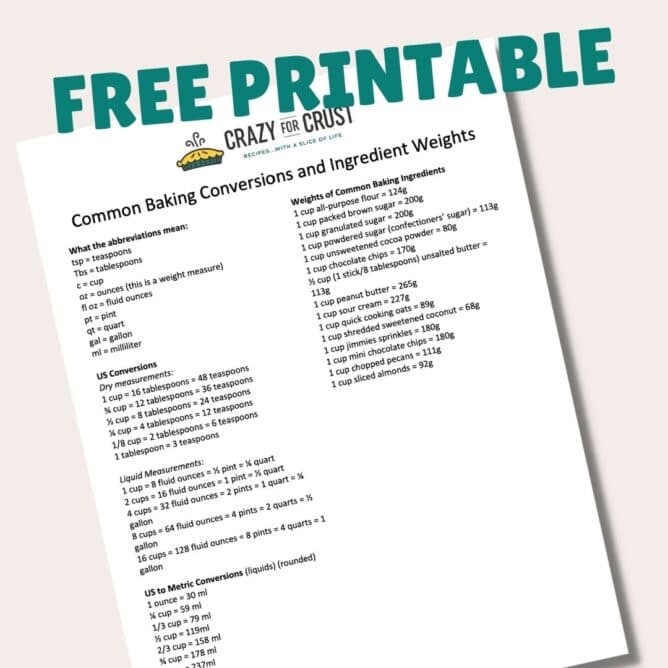This post may contain affiliate links. For more information, read my disclosure policy.
Learn all about the common baking conversions and common ingredient weights for baking. Learn the difference between US measuring and the metric system and get a FREE printable chart with all the information you need!

Become a better baking and never worry about kitchen conversions again when you use my free printable chart!
US vs Metric Measurements
In the United States we use the cups and tablespoon system for measuring, which is a volume system. The rest of the world mostly prefers metric measurements – measuring by weight.
The US system can be very confusing because 1 cup refers to both dry volume (1 cup of flour) and liquid volume (1 cup of milk). This can lead to some confusion, so it’s time to break it all down.
The metric system is actually such an easier method for cooking and baking: weights are in grams and liquids are in milliliters and there is much less guesswork.
For example: 1 cup of flour, when measured incorrectly, can actually be up to double the amount that’s actually needed. If you weigh the flour to start there is never any question!
US Conversion Charts
When it comes to measuring wet and dry ingredients, the measurements are the same but the vehicles are different. Learn about why we use wet and dry measuring cups. You can use a dry measuring cup or a liquid one for oil or flour, but one is just easier than the other.
The real difference when thinking about wet vs dry comes when you’re weighing ingredients.
In recipes, if you see a dry ingredient measured in ounces, they’re talking about weight not volume. Fluid ounces is talking about volume, so it’s an important distinction, and why using grams and mL are so much easier!
Dry Measurement Chart
- 1 cup = 16 tablespoons = 48 teaspoons
- ¾ cup = 12 tablespoons = 36 teaspoons
- ½ cup = 8 tablespoons = 24 teaspoons
- ¼ cup = 4 tablespoons = 12 teaspoons
- 1/8 cup = 2 tablespoons = 6 teaspoons
- 1 tablespoon = 3 teaspoons
Liquid Measurement Chart
- 1 cup = 8 fluid ounces = ½ pint = ¼ quart
- 2 cups = 16 fluid ounces = 1 pint = ½ quart
- 4 cups = 32 fluid ounces = 2 pints = 1 quart = ¼ gallon
- 8 cups = 64 fluid ounces = 4 pints = 2 quarts = ½ gallon
- 16 cups = 128 fluid ounces = 8 pints = 4 quarts = 1 gallon

US to Metric Conversion Chart
When we talk about converting US measurements to metric measurements, the only one that’s easy to do without a scale are fluid ounces. I only convert cups to fluid ounces or milliliters (not grams) because the weight of an ingredient varies differently. However, 10ml is 10ml, no matter what you fill it with.
- 1 ounce = 30 ml
- ¼ cup = 59 ml
- 1/3 cup = 79 ml
- ½ cup = 119ml
- 2/3 cup = 158 ml
- ¾ cup = 178 ml
- 1 cup = 237ml
Common Baking Measurement Tools
The most common baking tools in the US are cups, tablespoons, and teaspoons.
The rest of the world (and an increasing number of home bakers here in the US) are using a kitchen scale.
I have posts that talk about both subjects at length:
If you ever decide to start using a kitchen scale, my OXO scale is my favorite.
Tips for measuring ingredients
- Always spoon and level your flour – never scoop or pack it.
- Learn how to measure sugar
- When using a scale, make sure to stick to one set of weights (see below)
- Be sure to zero out your scale (also known as “tare”) once you put a bowl or plate on it, so it doesn’t calculate the weight of the bowl.
- Use dry cups for dry ingredients, liquid cups for liquids, and a sticky measuring cup for peanut butter and other sticky ingredients.
Again, grab a FREE printable chart cooking measurements of all of these so you never have to guess again!
These measurements will help me a lot with a class I’m taking in the fall. Thank you.
Thank you for the common baking conversions chart. I always have to look it up.
This is great info and all on one page! Thank you!!!
Featured In